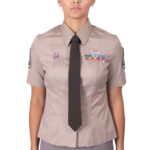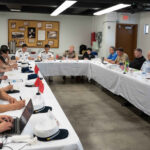Just over two years ago, my journey into the Star Wars costuming universe began with the Rebel Legion. It was thrilling to have my Jedi Archivist costume, mostly self-made, approved. This sparked a passion that led me down an unexpected path, eventually to the ranks of the “bad guys” of Star Wars, the 501st Legion, in an Imperial Officer uniform.
My fascination with costuming isn’t complex. I’ve always been drawn to clothing, eager to learn sewing, and captivated by the Star Wars aesthetic. Costuming seemed the perfect portal to connect with fellow Star Wars enthusiasts. As a confessed science fiction and fantasy geek, I deeply respect the artistry behind authentic costumes. For me, costuming is a creative outlet, much like running is for athletes or passionate sports fans painting their faces. It’s about expressing my Star Wars love, supporting charities, and engaging with my community in a unique way.
The Rebel Legion, which I initially joined, is part of a wider network of Star Wars costuming communities, including the Mandalorian Mercs and DroidBuilders. The most renowned, however, is the 501st Legion, famous for portraying the saga’s villains, particularly Stormtroopers, under the banner “Bad Guys Doing Good.” Initially, the 501st was my target due to their history and reputation, gleaned from my academic explorations of Star Wars culture. I’d likely seen them at film premieres or in fan films like Troops, but it was Chris Taylor’s How Star Wars Conquered the Universe that truly illuminated their purpose and impact.
Taylor recounts the 501st’s inception in 1997 by Albin Johnson and Tom Crews, who envisioned costuming as a gateway into the Star Wars realm.[1] They quickly grasped the power of numbers; a lone Stormtrooper is curious, but a group is a spectacle, an effect amplified online and through Lucasfilm invitations. The 501st has since blossomed into a global organization with over 15,000 members. Their mission, as stated on their website, extends beyond villainous cosplay to “bring good to our communities through volunteer charity work . . . to brighten the lives of the less fortunate and to bring awareness to positive causes.”[2] They achieve this through charity appearances, hospital visits, and fundraising.
Joining the 501st demands choosing a “bad guy” costume and meticulously crafting or acquiring every component to their stringent “screen accuracy” standards. This principle, shared by groups like the Rebel Legion, aims to replicate the on-screen experience and maintain uniform quality.[3] Essentially, members strive for head-to-toe authenticity, a kind of magic in itself.
With support from my local garrison, I undertook creating an Imperial Security Services Officer uniform. The jacket, especially, was a sewing Everest. Yet, it passed muster, and my 501st application was accepted. Despite this victory, and months of work, I felt hesitant about wearing it. Villainy isn’t my natural inclination. I see myself as a “good guy” – a Jedi, a scholar, a teacher, a defender of light. The uniform, while striking, carries a sharper edge.
The Shadow of Real-World Uniforms
The original Star Wars films intentionally drew visual parallels between Imperial Officer uniforms and Nazi German uniforms, particularly the Panzer officers’ cut.[4] My 501st mentor, a skilled seamstress, advised me to transport the uniform in a garment bag and dress in private, always ensuring context by being surrounded by other Star Wars characters. Her warning was stark: “Someone—especially these days—might mistake you for a Nazi.” Sound advice, yet it amplified my unease.
This raises questions about the “penchant for villainy.” Is it embracing darkness or a desire for power? The 501st’s code mandates respectful conduct and strictly prohibits harassment based on prejudice.[5] Yet, social media photos of my completed uniform drew questions, notably from a religious sister. I explained we keep the fascism fictional, but her and my own doubts lingered as my first 501st event approached.
A podcast comment further fueled my apprehension, suggesting it was disturbing to dress as villains and that the 501st might attract right-wing members. This anecdotal remark, a product of our polarized times, implied a link between villain costuming and fascism. This sparked a reaction in me, not of agreement, but of defiance. It clashed sharply with my experience. Having been involved with the 501st for over two years, I know firsthand their political diversity and their policy of political neutrality.
“Bad Guys Doing Good”: The Reality of the 501st Legion
These “bad guys” are, in reality, incredibly kind, helpful, and community-focused. Beyond charity fundraising, they support each other, offering aid during personal hardships. The garrison fosters a supportive social network, combating the challenge of adult friendships by providing shared-interest community and diverse perspectives. In essence, the 501st embodies “Bad Guys Doing Good” in meaningful ways, both publicly and privately.
Why then, this embrace of villainy? Members often joke that “bad guys have more fun” or are more “interesting,” especially in Star Wars. Children are drawn to iconic helmets of Darth Vader, Stormtroopers, and TIE Pilots. These helmets also serve as emotional shields during hospital visits, masking members’ own pain.[6]
But perhaps there’s a deeper, even unconscious motivation. Maybe portraying a villain is a form of empathy, not darkness. Claire Dederer’s Monsters: A Fan’s Dilemma offers insight into loving art by “problematic” creators. Dederer argues against severing ties with such works, emphasizing our evolving relationship with art and artists.[7] We can love a work, grapple with the artist’s flaws, and return with a “more knowing way.”[8] This dynamic mirrors how we love imperfect people in real life. Dederer suggests loving flawed figures reflects “the durable nature of love,” bridging divides and reminding us of our own undeserved, yet persistent, loveability.[9]
Monsters suggests that engaging with “villainous” art can be an act of love and understanding. This resonated deeply with my 501st experience. Could dressing as a bad guy be a similar act of empathy, mercy, forgiveness, and humanity? For me, it began to feel that way.
By my first 501st event, my reservations had largely dissolved. The group welcomed me warmly, cookies in hand. It was Star Wars night at a baseball game, filled with excited families. Everyone wanted photos. I stayed close to Darth Vader, posing and enjoying the evening. I had nervously pondered my villainous catchphrase. “Hello there” and “May the Force be with you” were out. “This is the Way” felt off. But as I stood with my fellow “bad guys,” in uniform, the answer emerged: “Long live the Empire!” It was the perfect blend of character, camaraderie, and Star Wars spirit.
[1] Chris Taylor, How Star Wars Conquered the Universe (New York: Basic Books, 2014), 28.
[2] “501st Legion and Charity,” 501st website, accessed September 14, 2023, https://www.501st.com/.
[3] Andrew Liptak, Cosplay: A History (New York: Saga Press, 2022), 68–69.
[4] Tony Keen, “I, Sidious,” in Star Wars and History, ed. Nancy R. Reagin and Janice Liedel (Hoboken, NJ: John Wiley & Sons, Inc., 2013), 144.
[5] “Operations Protocol/Legion Charter,” 501st website, accessed September 16, 2023.
[6] Tom Betti and Phillip Keene, “Tom Betti and a Rock Song about History,” August 18, 2023, on The Pan Am Podcast, produced by Tom Betti for the Pan Am Museum.
[7] Claire Dederer, Monsters: A Fan’s Dilemma (New York: Alfred A. Knopf, 2023), 252.
[8] Ibid.
[9] Ibid., 256.
By Emily Strand
A Defense of Devil Costumes
Justin Shaun Coyle


